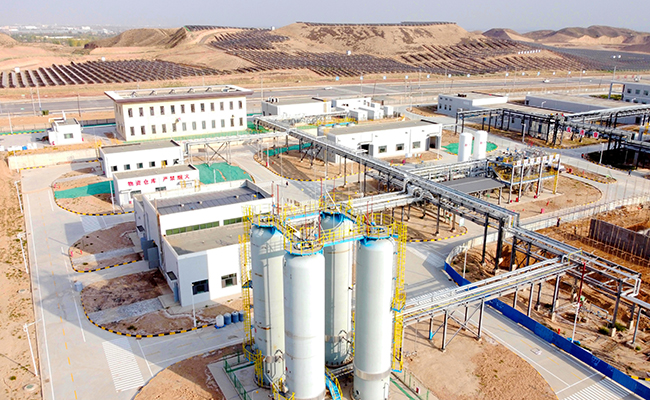
The potential of renewable energy in China is huge. Replacing fossil fuels with renewable energy and lowering carbon emissions have become important issues for sustainable development.
Recently, a research team led by Prof. LI Can from the Dalian Institute of Chemical Physics (DICP) of the Chinese Academy of Sciences and their collaborators industrialized the liquid solar fuel production through the "Liquid Solar Fuel Production demonstration Project".
They used commercial photovoltaic technology to generate electric power, the independently developed alkaline water electrolysis catalysts to produce renewable hydrogen, and carbon dioxide hydrogenation catalyst to produce methanol in the end. Therefore, the liquid solar fuel production was called "liquid sunshine".
"It is a new way for the large scale production of green liquid fuels with renewable energy," said Prof. LI.

The plant of "Liquid Solar Fuel Production demonstration Project" (Image by DICP)
One of the key innovative technologies of the project is the efficient, low-cost and long-lifetime electrocatalyst for alkaline water electrolysis in hydrogen production, which had been approved to be best electrocatalyst reported so far for large-scale alkaline water. The facility had a capacity for production of more than 1,000 standard cubic meters of hydrogen per hour on a single set of industrial electrolytic cells, and the unit hydrogen energy consumption was reduced to less than 4.3 kilowatt hours per cubic meter.
The other is the low-cost, high-selectivity and high-stability carbon dioxide hydrogenation catalyst for methanol production. The zinc oxide/zirconium oxide bimetallic oxide solid solution catalyst had achieved 1,000 tons/year green methanol synthesis. The selectivity of methanol reached 98%, and the content of methanol in reached 99.5%. What's more, the catalyst was resistant to poisoning and sintering.
The plant of the "Liquid Solar Fuel Production demonstration Project" consisted of three basic units: solar photovoltaic for renewable electricity generation, alkaline water electrolyzer for green hydrogen production, and methanol synthesis by carbon dioxide hydrogenation.
The photovoltaic power station with a total power of 10 MW provided electricity for alkaline water electrolyzer to hydrogen production, which was used in the end station for carbon dioxide hydrogenation to produce methanol.

86-10-68597521 (day)
86-10-68597289 (night)

52 Sanlihe Rd., Xicheng District,
Beijing, China (100864)

